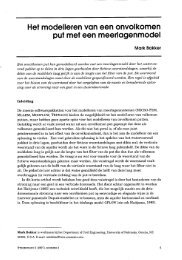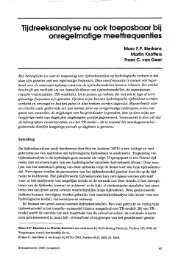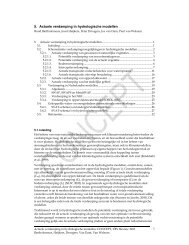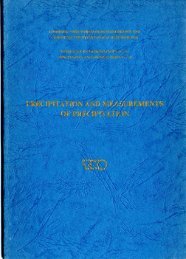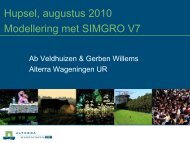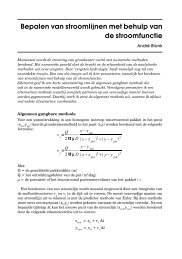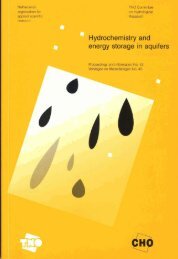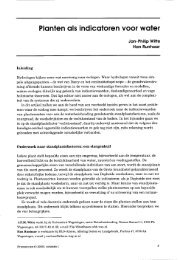Hydro-ecological relations in the Delta Waters
Hydro-ecological relations in the Delta Waters
Hydro-ecological relations in the Delta Waters
You also want an ePaper? Increase the reach of your titles
YUMPU automatically turns print PDFs into web optimized ePapers that Google loves.
tracefore possible to convert <strong>the</strong> absolute measlured concentrations to<br />
an equivalent concentration that would be expected <strong>in</strong> a standard river<br />
bed with 550 ~f <strong>the</strong> gra<strong>in</strong> fraction less than 16 um.<br />
The separation of <strong>the</strong> Eastmrn Scbeldt and Lake Erevel<strong>in</strong>gen from <strong>the</strong><br />
water flow<strong>in</strong>g <strong>in</strong> <strong>the</strong> rivers Rh<strong>in</strong>e ad Meuse has resulted <strong>in</strong> rema<strong>in</strong><strong>in</strong>g<br />
extremely low on cent rations <strong>in</strong> <strong>the</strong>se areas. The values found <strong>in</strong> <strong>the</strong><br />
Eastern ScheldC are thought to approximate to natural hackground<br />
levels. The concentration <strong>in</strong> Lake Orevel<strong>in</strong>gen is known ta be aamedhat<br />
higher. Unlike <strong>the</strong> Eastern Scheldt, this lake becm stagnant after its<br />
closnre. .As a consequence, <strong>the</strong>re is less <strong>in</strong>teraction between <strong>the</strong> water<br />
<strong>in</strong> <strong>the</strong> lake a d <strong>the</strong> bed deposits (resuspenaioe) <strong>in</strong> Lake CreveUngen<br />
than <strong>in</strong> <strong>the</strong> Eastern Scheldt. This expla<strong>in</strong>s why <strong>the</strong> concentration of<br />
contam<strong>in</strong>ants <strong>in</strong> this lake still approaches <strong>the</strong> pre-1965 values.<br />
The lake beds and river beds <strong>in</strong> <strong>the</strong> s,e4imentatlon areas <strong>in</strong> <strong>the</strong> nor<strong>the</strong>rn<br />
part of <strong>the</strong> <strong>Delta</strong> are hewily polluted. In <strong>the</strong> eastern part (Nieuwe<br />
MerwBde/&met) high contam<strong>in</strong>ation levels have been detected, affectiqg a<br />
layer at least 2 metres thick. Zhis material was deposited between 1970<br />
and 1975. As an equilibrium has now developed between <strong>the</strong> hydraulic and<br />
morphalugtcal precesses, it is unlikely tKat this la~rer will be coveted<br />
by new se&ments <strong>in</strong> <strong>the</strong> future.<br />
The central section of <strong>the</strong> <strong>Delta</strong> (Hollands Diep) hag a thick layer of<br />
less polluted river sediment that was deposited <strong>in</strong> <strong>the</strong> years aftek<br />
1975. However, more contam<strong>in</strong>ated material from <strong>the</strong> 1970-1975 period is<br />
contaised below this layer. Underneath <strong>the</strong>se layers can be fonnd<br />
estuar<strong>in</strong>e sediments from *he period before 1970. l'he different layers<br />
referred to above can be qlearly dlvt<strong>in</strong>g=ished fro= core samples taken<br />
from <strong>the</strong> area (Fig. 6). It is reesgnized that <strong>the</strong> quality of <strong>the</strong> tap<br />
layer of sediment will improve as <strong>the</strong> quality of <strong>the</strong> surface water<br />
iaproves.





